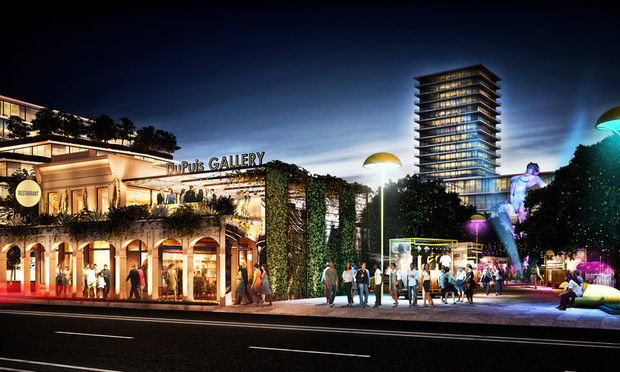 A rendering of part of the planned, nearly 18-acre Magic City Innovation District in Little Haiti. It would rise between Northeast Second Avenue and the Florida East Coast Railway tracks and from the Little Haiti Soccer Park and the Little Haiti Cultural Center. Courtesy image.
A rendering of part of the planned, nearly 18-acre Magic City Innovation District in Little Haiti. It would rise between Northeast Second Avenue and the Florida East Coast Railway tracks and from the Little Haiti Soccer Park and the Little Haiti Cultural Center. Courtesy image.
A Miami planning board wants the city to do away with a controversial provision that eases the way for major projects after some Little Haiti residents claimed three nearby proposals would overwhelm their neighborhood.
The Planning, Zoning and Appeals Board voted 6-3 on Wednesday to urge repeal of rules for Special Area Plans. The City Commission is to consider the board's recommendation at a future meeting and has the final say. No date has been set.
The commission itself has taken issue with the Miami 21 zoning overhaul adopted in 2009, voting last month to appoint a review task force.
SAPs allow owners who amass 9 or more contiguous acres to build higher and denser than would otherwise be allowed in exchange for pledging community benefits such as public parks or affordable housing.
The most controversial SAPs are the approved 18-acre Magic City Innovation District to rise in Little Haiti and the nearby proposed Eastside Ridge. The developer sued the city after the planning board delayed a vote on its project five times.
Both projects would bring mixed-use developments with high-rises to a low-rise neighborhood dominated by low- and moderate-income residents who live and shop in the area.
Beyond complaints about gentrification and project scale, concerns extend to climate change gentrification where residents are pushed out of neighborhoods on higher, more sea-level resilient ground.
In addition to the proposed Eastside and approved Magic City projects, the city has approved a SAP for expansion of the Miami Jewish Health Systems campus across the street from the Eastside SAP.
The push for repeal of the governing SAP provisions was welcomed opponents, including 13 who spoke at Wednesday's meeting.
"SAPs are an evil monster," Morningside residents Elvis Cruz said. "I assume you know a 24-story building is not in character of a three-story-building neighborhood."
Akerman office managing partner Neisen Kasdin, who has represented several SAP developers including the Magic City Innovation District, said some SAPs have helped Miami grow into a preeminent city but conceded bad SAPs have been proposed as well.
He warned against repeal.
"You are not throwing out the baby with the bathwater. You are throwing out the baby. Think before you take a step like this, which could actually stop the best developments the city has ever seen," he told the board.
Repeal would result in "piecemeal" development, and the city would lose the power to negotiate community benefits, Kasdin said.
He and some opponents agreed on one thing: Some SAPs have worked well, notably Brickell City Centre and the Miami Design District.
They "are now substantially complete and are considered among the finest, best planned developments in this country in recent years," said Kasdin, who represented both developers.
The dissenting votes were by board members Chris Collins, Manuel Vadillo and Adam Gersten.
Gersten in meetings last year suggested guiding the development conversation to change the SAP process. On Wednesday, he asked the board to include in its resolution the reasons why it's asking for repeal and include input from attorneys, residents and other stakeholders.
Board member Alex Dominguez, who made the motion for the repeal, opposed Gerstein's idea.
"What it's going to do is water it down and then you are going to start splitting hairs and go into the weeds," Dominguez said.
Related stories:
Back to the Drawing Board? Miami Planning Board Evaluating Special Area Plans
© Touchpoint Markets, All Rights Reserved. Request academic re-use from www.copyright.com. All other uses, submit a request to [email protected]. For more inforrmation visit Asset & Logo Licensing.







